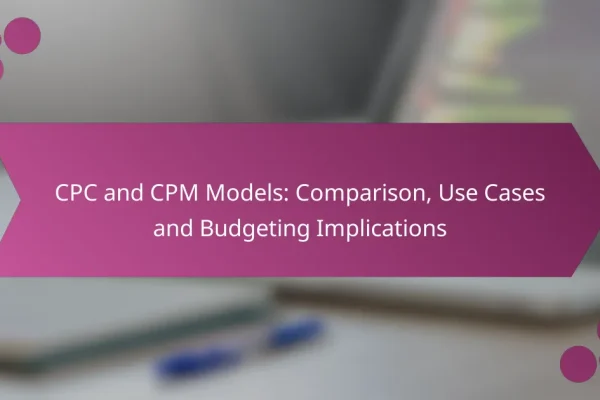How to create a display advertising budget in Ireland?
Creating a display advertising budget in Ireland involves setting clear objectives, understanding your audience, and estimating costs across various channels. This structured approach ensures effective allocation of resources to maximize advertising impact.
Define advertising goals
Start by establishing specific advertising goals that align with your overall marketing strategy. Common objectives include increasing brand awareness, generating leads, or driving sales. Clearly defined goals will guide your budgeting decisions and help measure success.
For example, if your goal is to boost brand awareness, you might allocate a larger portion of your budget to high-visibility platforms like social media or display networks.
Analyze target audience
Understanding your target audience is crucial for effective display advertising budgeting. Identify demographics such as age, gender, location, and interests to tailor your messaging and select appropriate channels. This analysis helps ensure that your budget is spent on reaching the right people.
Utilize tools like Google Analytics or social media insights to gather data about your audience’s online behavior and preferences, which can inform your budget allocation.
Estimate costs per channel
Estimating costs per channel involves researching the average costs associated with different advertising platforms. In Ireland, display advertising costs can vary widely, typically ranging from a few euros to several hundred euros per thousand impressions (CPM).
Consider factors such as the platform’s reach, targeting options, and ad formats when estimating costs. For example, programmatic advertising may offer competitive rates but requires careful management to optimize spending.
Allocate budget across platforms
Once you have defined your goals, analyzed your audience, and estimated costs, allocate your budget across selected platforms based on their effectiveness in reaching your objectives. A balanced approach may involve distributing funds among social media, search engines, and display networks.
Regularly review performance metrics to adjust your budget allocation as needed. For instance, if a particular platform yields higher engagement rates, consider increasing its budget share to capitalize on that success.
What are the key factors affecting display advertising costs?
Display advertising costs are influenced by several key factors, including ad placement, creative design expenses, and bid strategies. Understanding these elements can help advertisers optimize their budgets and improve campaign effectiveness.
Ad placement and targeting
Ad placement refers to where your ads appear, such as on specific websites or within particular content categories. Targeting options, like demographic or geographic targeting, can significantly affect costs; more precise targeting often leads to higher expenses but can yield better results.
For instance, placing ads on high-traffic sites or targeting niche audiences may increase costs but can improve engagement rates. Advertisers should evaluate the trade-offs between cost and potential reach when choosing placements.
Creative design expenses
Creative design expenses encompass the costs associated with developing ad visuals and copy. High-quality graphics and compelling messaging can enhance click-through rates, but they also require a budget for design resources, whether in-house or outsourced.
Typically, creative design costs can range from a few hundred to several thousand dollars, depending on complexity and the designer’s expertise. Investing in quality design is crucial, as it directly impacts the effectiveness of the ad campaign.
Bid strategies and competition
Bid strategies determine how much advertisers are willing to pay for ad placements, which can vary based on competition. In competitive markets, costs can rise significantly, requiring advertisers to adjust their bidding strategies to remain effective.
Common bidding strategies include cost-per-click (CPC) and cost-per-impression (CPM). Advertisers should regularly analyze their competition and adjust bids accordingly to maximize their return on investment while staying within budget constraints.
How to optimize display advertising spend?
To optimize display advertising spend, focus on strategic allocation of your budget based on performance metrics and audience insights. This involves continuous testing, monitoring, and adjusting your campaigns to ensure maximum return on investment (ROI).
Utilize A/B testing
A/B testing allows you to compare different versions of your ads to determine which performs better. By testing variations in visuals, copy, or calls to action, you can identify what resonates most with your audience.
Start with small changes, such as different headlines or images, and measure their impact on click-through rates and conversions. Aim for a sample size that provides statistically significant results, typically in the hundreds or thousands, depending on your overall traffic.
Monitor campaign performance
Regularly monitoring your campaign performance is crucial for optimizing spend. Use analytics tools to track key metrics like impressions, clicks, conversions, and cost per acquisition (CPA).
Set benchmarks for success based on historical data and industry standards. Adjust your strategy if certain ads underperform, reallocating budget to higher-performing campaigns to maximize overall effectiveness.
Adjust bids based on ROI
Adjusting bids based on ROI is essential for effective cost management in display advertising. Analyze the performance of each campaign to determine which ads yield the best returns and increase bids accordingly.
Consider implementing automated bidding strategies that adjust in real-time based on performance data. This can help you maintain competitive positioning while ensuring that your budget is spent efficiently.
What tools can help manage display advertising budgets?
Several tools can assist in managing display advertising budgets effectively, allowing marketers to optimize their spending and maximize return on investment. These tools provide insights, forecasts, and performance tracking to ensure budgets are allocated efficiently.
Google Ads Budget Planner
The Google Ads Budget Planner is a powerful tool that helps advertisers estimate their budget needs based on historical performance and projected outcomes. It allows users to input various parameters, such as campaign goals and target audience, to generate budget recommendations.
When using the Budget Planner, consider setting realistic goals and reviewing past campaign data to inform your budget decisions. Regularly updating your budget based on performance metrics can lead to better results over time.
AdEspresso by Hootsuite
AdEspresso is a user-friendly platform designed for managing Facebook, Instagram, and Google Ads campaigns. It offers budget management features that allow users to set daily or lifetime budgets and monitor spending in real-time.
This tool provides detailed analytics and A/B testing capabilities, helping advertisers identify which ads perform best within their budget. Utilize its reporting features to adjust your strategy and optimize ad spend effectively.
Facebook Ads Manager
Facebook Ads Manager is essential for managing advertising budgets on Facebook and Instagram. It offers comprehensive budget controls, enabling advertisers to set daily or lifetime budgets and allocate funds across multiple campaigns.
To maximize your budget, regularly analyze performance metrics and adjust bids based on ad engagement. Be mindful of audience targeting to ensure your budget is spent effectively, reaching the most relevant users for your campaigns.
What are common mistakes in display advertising budgeting?
Common mistakes in display advertising budgeting can lead to overspending or ineffective campaigns. Key pitfalls include underestimating creative costs and neglecting audience research, both of which can significantly impact overall campaign performance.
Underestimating creative costs
Many advertisers fail to accurately budget for creative costs, which can include design, copywriting, and production expenses. Depending on the complexity of the ads, these costs can range from hundreds to thousands of dollars. It’s crucial to allocate sufficient funds for high-quality creative work to ensure the ads resonate with the target audience.
When planning your budget, consider the entire creative process. This includes not just initial design but also revisions and potential A/B testing. A good rule of thumb is to allocate at least 20-30% of your total budget to creative development.
Neglecting audience research
Failing to conduct thorough audience research can lead to misguided spending and ineffective ad placements. Understanding your audience’s demographics, interests, and online behavior is essential for targeting ads effectively. Without this insight, you risk wasting budget on impressions that do not convert.
Invest time in gathering data through surveys, analytics, and market research. This information should inform your budgeting decisions, ensuring that funds are directed toward channels and formats that align with your audience’s preferences. Aim to allocate a portion of your budget—around 10-15%—to research and analysis to optimize your campaign’s effectiveness.











